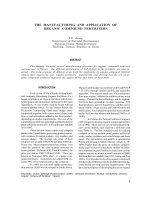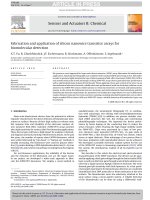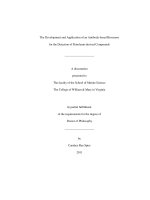Adaptation and application of a state of the art impedance analyzer for characterization of silicon p i n diodes
Bạn đang xem bản rút gọn của tài liệu. Xem và tải ngay bản đầy đủ của tài liệu tại đây (2.76 MB, 88 trang )
ADAPTATION AND APPLICATION OF A STATE-OF-
THE-ART IMPEDANCE ANALYZER FOR
CHARACTERIZATION OF SILICON P-I-N DIODES
PANJI G. I. SURYACANDRA
NATIONAL UNIVERSITY OF SINGAPORE
2011
ADAPTATION AND APPLICATION OF A STATE-OF-THE-
ART IMPEDANCE ANALYZER FOR CHARACTERIZATION OF
SILICON P-I-N DIODES
PANJI G. I. SURYACANDRA
(B. Eng., Engineering Physics, Institut Teknologi Bandung)
A THESIS SUBMITTED
FOR THE DEGREE OF MASTER OF ENGINEERING
DEPARTMENT OF MECHANICAL ENGINEERING
NATIONAL UNIVERSITY OF SINGAPORE
2011
i
ABSTRACT
Impedance spectroscopy is a powerful non-destructive characterisation technique
that studies the response of samples to alternating current (AC) excitations. From a
model based analysis of the impedance measurement, information on the sample
under test such as dielectric constant, layer thickness, and charge transport can be
obtained. In this master thesis project, a high precision impedance analyzer from
INPHAZE was successfully adapted and tested for impedance measurements of
semiconductor samples. The INPHAZE impedance analyzer has a very high phase
precision in the order of mili-degrees which has previously been employed for the
study of self-assembled mono-layers. As a proof of principle, hydrogenated
amorphous and microcrystalline silicon (a-Si:H and µc-Si) p-i-n diodes have been
studied in this thesis with the adapted INPHAZE impedance analyzer.
It was shown that the dynamics of mobile charge carriers in the neutral region of the
intrinsic layer of p-i-n diode manifests as an independent time constant, which is
larger than the time constant which represents dynamics of mobile charge carriers in
the depletion region of the diode. As a result, the number of time constants extracted
from the impedance spectrum of a p-i-n diode qualitatively reveals the electric-field
profile in the intrinsic layer of the diode. It was found that the measured impedance
spectrum of a-Si:H p-i-n diode with intrinsic layer of 250 nm at frequency range
between 10 Hz – 100 kHz consists of only one time constant. This indicates that the
intrinsic layer of the diode is fully depleted. In contrast, at similar range of frequency,
the impedance spectrum of µc-Si:H p-i-n diode with intrinsic layer thickness of 1000
nm consists of two time constants. The extra time constant found in impedance
spectrum of µc-Si:H p-i-n diode corresponds to the region in the intrinsic layer of the
diode where the electric field is negligibly small.
ii
However, there are fundamental limitations in the applicability of INPHAZE
impedance analyzer for measurement of these silicon-based diodes at frequency
below 1 Hz. In this range of frequency, the standard deviations of the measured
phase angle are typically not smaller than the phase angles of impedance of the
diodes. As a result, despite the very high phase precision of the INPHAZE
impedance analyzer, the capacitance of these silicon-based diodes at frequency
below 1 Hz is unable to be precisely determined.
Keywords: high precision impedance analyzer, low frequency phase angle,
capacitance, time constant, hydrogenated amorphous and microcrystalline silicon
iii
ACKNOWLEDGEMENTS
I would like to express my deepest gratitude to my supervisors, Asst. Prof. Palani
Balaya from Mechanical Engineering Department and Prof. Armin Aberle from Solar
Energy Research Institute of Singapore (SERIS), for the opportunity to work on an
interesting research topic and his encouragement, guidance and many invaluable
ideas during the research.
I am also extremely grateful to my SERIS daily supervisor, Dr. Bram Hoex, for his
guidance and patience. His invaluable comments has made breakthrough to the
whole research project.
I would also like to take this opportunity to thank SERIS for providing part time
research assistantship and excellent facilities, without which the present work would
not have been possible. Thanks also goes to the National University of Singapore for
giving me the opportunity to pursue postgraduate study. I want to express my
gratitude to all my colleagues at SERIS for creating a relaxed and pleasant working
atmosphere and to Mdm. Jenny Oh who assist the submission of this thesis.
Finally, I should acknowledge my family members. They showed so much concern
and care about me during the course of my study. Especially I want take this
opportunity to thank my parents and to my dearest Ms. Mira Larissa for her
encouragement and constant support contributed to the completion of this project.
iv
TABLE OF CONTENTS
ABSTRACT i
ACKNOWLEDGEMENTS iii
TABLE OF CONTENTS iv
SUMMARY vii
LIST OF FIGURES ix
LIST OF TABLES xii
List of Symbols and Abbreviations xiii
1. Introduction 1
1.1 Principles of Impedance Spectroscopy 1
1.1.1 Data Representations of Impedance Measurements 1
1.1.2 Basic Properties of Nyquist Plot and the Concept of Constant Phase
Elements (CPE) 2
1.2 Impedance Characteristics of Samples Containing Two or More Time
Constants 5
1.2.1 Relationship between Samples Time Constants and their Nyquist Plots 5
1.2.2 Relationship between Various Representations of Multilayer Dielectric
Impedance Data 7
1.2.3 Fitting of the Measured Impedance Spectrum 10
1.3 Low Frequency Capacitance Measurement of Semiconductors 10
1.3.1 Theoretical Formulation of Low Frequency Capacitance Error in
Semiconductors due to Inaccuracy in Phase Angle Measurement 11
1.3.2 Criteria for Precise Determination of Semiconductors’ Capacitance at Low
Frequency 13
1.4 Impedance Measurement for Analyzing Silicon-Based p-i-n Diodes 16
1.4.1 Characterization of Intrinsic Layer of Silicon-Based p-i-n Diodes 16
v
1.4.2 Potential Sources of Low Frequency Polarizing Elements in Silicon Based
p-i-n Diodes 20
1.5 Research Objective and Outline of the Thesis 22
1.6 References 23
2. Introduction to Impedance Analyzer from INPHAZE 25
2.1 Brief History of INPHAZE Impedance Analyzer 25
2.2 Applications of the INPAHZE Impedance Analyzer 26
2.3 References 28
3. The Application of INPHAZE Impedance Analyzer for Measurement of
Semiconductor Samples 29
3.1 Introduction 29
3.2 Schematic and Calibration of the INPHAZE Impedance Analyzer 29
3.2.1 Schematic of the INPHAZE Impedance Analyzer 29
3.2.2 Calibration of the INPHAZE Impedance Analyzer 32
3.3 Adapting the INPHAZE for Measurement of Semiconductor Samples 33
3.3.1 Connection to Probe-station and Avoiding of Ground Loop Noise 33
3.3.2 Stray Impedance at High Frequencies 34
3.4 Performance Characterization of INPHAZE for Impedance Measurement of
Semiconductor Samples 36
3.4.1. Experimental Evidence of Precision Loss in Semiconductor-like Standard
Samples’ Low Frequency Capacitance 36
3.4.2 Influence of the Applied AC amplitude on the Response Signal-to-Noise
Ratio of Semiconductor-like Standard Samples 38
3.4.3 Influence of Phase Angle Measurement Error and Theoretical Phase
Angles on the Precision of Semiconductors-like Standard Samples Capacitance
at Low Frequency 39
3.4.4 INPHAZE’s Low Frequency Capacitance Precision in Comparison with
another Impedance Spectrometer 42
3.5 Conclusion 43
3.6 References 44
4. Case Studies: Impedance Measurements on a-Si:H and µc-Si:H p-i-n Solar
Cell Diodes 45
vi
4.1 Introduction 45
4.2 Comparison of the Atomic Arrangement and Physical Properties of a-Si:H and
µc-Si:H 45
4.3 Description of the Samples and Measurement Procedures 48
4.4 Current – Voltage Measurement of a-Si:H and µc-Si:H p-i-n Diode 50
4.5 Low Frequency Impedance Measurement of a-Si:H and µc-SiH p-i-n Diodes52
4.6 Characterization of a-Si:H and µc-SiH p-i-n Diodes: Equivalent Circuit Analysis
56
4.6.1 The Construction of the Equivalent Circuit Models 56
4.6.2 Impedance Spectrum Analysis of a-Si:H and µc-Si:H p-i-n Diode 61
4.7 Effect of Forward Bias on Capacitance and Conductance of a-Si:H and µc-
Si:H p-i-n Diode 64
4.8 Conclusion 66
4.9 References 67
5. Conclusions & Recommendation 71
5.1 Conclusions 71
5.2 Recommendation 72
vii
SUMMARY
Impedance spectroscopy is a powerful non-destructive characterization technique
that studies the response of samples to alternating current (AC) excitations. From a
modeled based analysis of the impedance measurement, information from sample
under test, such as: dielectric constant, layer thickness, and charge transport can be
obtained. In this master thesis project, a high precision impedance analyzer from
INPHAZE was successfully adapted and tested for impedance measurements of
semiconductor samples. The INPHAZE impedance analyzer has a very high phase
precision in the order of mili-degrees which has previously been employed for the
study of self-assembled mono-layers. As a proof of principle, hydrogenated
amorphous and microcrystalline silicon (a-Si:H and µc-Si) p-i-n diodes have been
studied in this thesis with the adapted INPHAZE impedance analyzer.
INPHAZE impedance analyzer contains innovative algorithm which is able to extract
phase angle of impedance more accurate compared to standard impedance
machines. The phase angle standard deviation of INPHAZE impedance analyzer
connected to a probe-station was slightly dependent on the sample’s resistance as
well as on the applied AC voltage amplitude. The phase angle standard deviation
was around 2 mili degrees tested by a standard samples which consists of parallel
connected 100 Ohm standard resistor and 1 µF standard capacitor at measurement
frequency of 0.1 Hz. As a consequence of this small phase angle standard deviation,
the capacitance of standard semiconductor samples can be determined for one order
of magnitude of frequencies lower compared to by using a conventional impedance
analyzer.
viii
One example of the applicability of INPHAZE impedance analyzer connected to a
probe-station is to qualitatively reveal the electric field profile in the intrinsic layer of
p-i-n diodes. It was shown that the number of time constants extracted from the
impedance spectrum of a p-i-n diode qualitatively reveal the electric-field profile in the
intrinsic layer of the diode. It was found that the measured impedance spectrum of a-
Si:H p-i-n diode with intrinsic layer of 250 nm at frequency range between 10 Hz –
100 kHz consists of only one time constant. This indicates that the intrinsic layer of
the diode is fully depleted. In contrast, at similar range of frequency, the impedance
spectrum of µc-Si:H p-i-n diode with intrinsic layer thickness of 1000 nm consists of
two time constants. The extra time constant found in impedance spectrum of µc-Si:H
p-i-n diode corresponds to the region in the intrinsic layer of the diode where the
electric field is negligibly small.
However, there are fundamental limitations in the applicability of INPHAZE
impedance analyzer for measurement of these thin-film silicon-based diodes at
frequency below 1 Hz. The capacitance of a sample can be precisely determined
only at frequencies where the standard deviations of the measured phase angles of
impedance of the samples are significantly smaller than phase angles of impedance
of the sample. Due to significant noise caused by recombination activities of mobile
charge carriers, the typical standard deviations of impedance phase angles of µc-
Si:H p-i-n diodes, and especially a-Si:H p-i-n diodes at frequency below 1 Hz are not
smaller than the phase angle of impedance of the respective diodes. As a
consequence, despite the very high phase precision of the INPHAZE impedance
analyzer, the capacitance of silicon-based semiconductor diodes at frequency below
1 Hz is unable to be precisely determined.
ix
LIST OF FIGURES
Figure 1.1 The equivalent circuit model (a) and resulting Nyquist plot (b) of a sample
which consists of a conductive (metal) layer in contact with a dielectric layer. R
s
is metal’s resistance; R
p
is semiconductor’s resistance; C is semiconductor’s
capacitance. The arrow indicates the direction of increasing frequency ω. 4
Figure 1.2 The equivalent circuit model (a) and resulting Nyquist plot (b) of a sample
which consists of a conductive (metal) layer in contact with a dielectric layer. R
s
is metal’s resistance; R
p
is semiconductor’s resistance; CPE is semiconductor’s
frequency dependent capacitance and α represents the semicircle’s depression
angle. 5
Figure 1.3 The equivalent circuit of a three layer structure 6
Figure 1.4 Nyquist plot of thin film structures represented by Figure 1-3 (assumed
that τ
1
= R
1
x C
1
> τ
2
= R
2
x C
2
> τ
3
= R
3
x C
3
). 6
Figure 1.5 Equivalent circuit representation of a sample in the form of R (ω) – C(ω)
(left). Phase diagram representation of conversion between R (ω) – C(ω) pairs
to Re [Z(ω)] - Im [Z(ω)] (right) 8
Figure 1.6 Impedance Spectrum representations of two layers of dielectric layer with
various ratios of R1 x C1 / R2 x C2 9
Figure 1.7 [(a) – (b)] Example of phase angle - frequency, and, linear and logarithmic
plot of capacitance - frequency data for a circuit without low frequency
polarization element. [(c) – (d)] Example of phase angle - frequency, and, linear
and logarithmic plot of capacitance - frequency data for a circuit with low
frequency polarization element 14
Figure 1.8 Top: Simulated band diagram of a-Si:H p-i-n diode with intrinsic layer
thickness of 1000 nm at zero DC bias condition. Bottom: Simulated band
diagram of a-Si:H p-i-n diode with intrinsic layer thickness of 250 nm at zero DC
bias condition. 17
Figure 1.9 Top: Simulated band diagram of a-Si:H p-i-n diode with intrinsic layer
thickness of 250 nm at forward DC bias of 0.7 V. Bottom: Simulated band
diagram of a-Si:H p-i-n diode with intrinsic layer thickness of 1000 nm at forward
DC bias of 0.7 V. 18
Figure 2.1 (Top): Self-assembled monolayers which consist of alkane chains of
various lengths. (Bottom): Relationship between chain length of the SAM,
thickness of the film, and capacitance at 0.558 Hz. 27
x
Figure 2.2 (Upper Left): Structure and equivalent circuit model of a self-assembled
monolayer, which consists of carbon chains and a functionalized group. (Lower
Left): Schematic of three-terminal configuration. (Right): Capacitance and
conductance spectrum of SAM with and without functionalized group. 27
Figure 3.1 Schematic of the INPHAZE system. 30
Figure 3.2 Left: INPHAZE’s amplifier board. Right: INPHAZE’s signal generator 30
Figure 3.3 Arrangement of standard elements in the amplifier board 33
Figure 3.4 Upper left: photo of the sample holder and four micro-probes. Upper right:
photo of probe-station’s shield and temperature controller. Lower left: the
schematic connection diagram between impedance analyzer and probe-station.
Lower right: the blue lines on the top figure refer to sample’s response signal
before proper grounding (with ground-loop noise); the blue lines on the bottom
figure refer to sample’s response signal after proper grounding. 34
Figure 3.5 Capacitance and conductance spectrum of 1 kOhm resistor in parallel with
100 nF resistor measured by INPHAZE impedance analyzer with and without
connected to probe-station. 35
Figure 3.6 Capacitance, conductance, phase angle, and, magnitude of impedance of
100 nF, 1 kOhm // 100 nF, 100 Ohm // 100 nF, and, (1 kOhm // 100 nF) in
parallel with (10 kOhm // 1 F) standard sample. Dot indicates median, error bar
indicates maximum and minimum value from 7 measurements. Note that the 1 F
capacitor is not a proper standard capacitor and contains significant magnitude
of series resistance. 36
Figure 3.7 Snapshot of the sinusoidal waveform from measurement of 1kOhm // 1
micro F standard sample at 30 mV and 10 mV 38
Figure 3.8 Phase angle, Capacitance, Standard Deviation (SD) of Phase Angle, and
SD of Phase/ theoretical Phase angle of 1kOhm // 1 µF and 100 ohm // 1 µF.
The vertical line points to the frequency at which scattering of capacitance start
to occur. 41
Figure 3.9 Capacitance and Phase angle measurement of 100 Ohm // 100 nF
standard sample. Median and error bar (standard deviation of data) is taken from
5 measurements. The vertical line points to the frequency at which scattering of
capacitance start to occur 43
Figure 4.1 Upper left: schematic of crystal structure of crystalline silicon. Upper right:
schematic of atomic structure of amorphous silicon, some silicon dangling bonds
are passivated by hydrogen, and some are left unpassivated. Bottom: effective
density of states of amorphous silicon as a function of electron energy [1-2] 46
xi
Figure 4.2 (a) Schematic of the structure of a-Si:H and µc-Si:H thin film solar cells
diode. (b) Schematic of the structure of µc-Si:H thin film solar cells diode. 49
Figure 4.3 Photo of a-Si:H sample (left) and µc-Si:H sample (right) used in this thesis.
49
Figure 4.4 Left: the measured dark current-voltage of µc-Si:H p-i-n diodes. Right: the
measured dark current-voltage of a-Si:H p-i-n diodes 51
Figure 4.5 Top: Minimum, maximum, and, median of (top) capacitance and
conductance of a-Si:H and µc-Si:H p-i-n junction solar cells obtained from 7
consecutive measurements. Bottom: phase angle of µc-Si:H (left) and a-Si:H
(right) solar cell samples obtained from 7 consecutive measurements. 53
Figure 4.6 Phase angle standard deviation of a-Si:H and µc-Si:H solar cells, and, 1
kOhm standard resistor in parallel with 1 µF standard capacitor at 30 mV of AC
Amplitude. 54
Figure 4.7 Left: Experimental Nyquist plot of µc-Si:H p-i-n diode sample at 300 – 330
K (dots) and its equivalent circuit fitting curves (line). Right: Experimental
Nyquist plot of a-Si:H p-i-n diode sample at 300 – 330 K (dots) and its equivalent
circuit fitting curves (line). 56
Figure 4.8 Experimental data of capacitance and conductance of µc-Si:H p-i-n diode
at 300 – 330 K (dots) and their equivalent circuit fitting curves (line). 57
Figure 4.9 Experimental data of capacitance and conductance of a-Si:H p-i-n diode at
300 – 330 K (dots) and their equivalent circuit fitting curves (line) 57
Figure 4.10 The equivalent circuit representation of µc-Si:H (left) and a-Si:H (right) p-
i-n diode sample which is used to model the measured impedance data 58
Figure 4.11 Top: Experimental Nyquist plot of µc-Si:H p-i-n diode sample at 300 K
(dots) and its best-fit one time constant fitting curves (line). Bottom:
Experimental Nyquist plot of a-Si:H p-i-n diode sample at 300 K (dots) and its
best-fit one time constant fitting curves (line) 60
Figure 4.12 Capacitance per Area and Conductance per Area of a-Si:H p-i-n diode at
50 mV and 200 mV DC bias. 64
Figure 4.13 Capacitance per Area and Conductance per Area of µc-Si:H p-i-n diode
at 50 mV and 200 mV DC bias. 65
xii
LIST OF TABLES
Table 4.1 Comparison of the key properties (atomic density, band gap, conductivity,
dielectric constant, and dangling bond density) of c-Si, a-Si:H, and, µc-Si:H 47
Table 4.2 Key properties of a-Si:H and µc-Si:H samples used in this thesis. 50
Table 4.3 The extracted resistances and capacitances from impedance
measurements of µc-Si:H p-i-n diode samples at 300 K - 330 K 62
Table 4.4 The extracted resistances and capacitances from impedance
measurements of a-Si:H p-i-n diode samples at 300 K - 330 K 62
Table 4.5 The extracted time constants of µc-Si:H p-i-n diode samples at 300 K - 330
K 62
xiii
List of Symbols and Abbreviations
Symbol Description
A Area
AC Alternating Current
C Capacitance
C* Complex capacitance
CPE Constant Phase Elements
d Thickness
DC Direct Current
E
c
Energy of
Conduction Band
E
f
Fermi Energy
E
v
Energy of
Valence Band
G Conductance
Im(Z) Imaginary part of impedance
k Kilo
n Refractive index
P Non-ideality factor of Constant Phase Element
Re(Z) Real part of impedance
R
p
Parallel Resistance
Rs Series Resistance
SAM Self-Assembled Monolayers
t Time
T Pre-factor of Constant Phase Element
V
bi
Built-in voltage
xiv
V
bi0
Built-in voltage at zero Volt condition
∆Φ Error of phase angle
∆C Error of capacitance
ε* Complex dielectric constant
ε’ Real part of dielectric constant
ε’’ Imaginary part of dielectric constant
σ Conductance
τ Time constant of an RC element
AC
V Alternating Current (AC) Voltage
AC
I Alternating Current
DC
V Direct Current (DC) Voltage
DC
I Direct Current
*
Z
Electrical impedance in complex form
Z
Magnitude of impedance
CPE
Z Impedance of Constant Phase Element
θ
∠
Phase angle of impedance
ϖ
Frequency (in radian)
1
1. Introduction
1.1 Principles of Impedance Spectroscopy
Impedance spectroscopy is a material characterization technique which non-
destructively studies the response of samples to alternating current (AC) excitations.
In electrical impedance spectroscopy, an alternating current (AC) is driven through a
sample under test and the relative amplitude and phase of the alternating current
(I
AC
) and voltage (V
AC
) are measured. Typically the AC impedance is measured for a
wide frequency (ω) range (millihertz to megahertz), and information from the sample
is extracted from a model-based analysis.
The measured impedance of a sample can be described by the equation below:
(
)
(
)
(
)
ϖϖϖ
Φ∠== ZIVZ
ACAC
/*
.
(1.1)
where |Z(ω)| is the ratio of amplitude between voltage amplitude and current
amplitude, and, Φ (ω) the phase shift between current and voltage signal.
1.1.1 Data Representations of Impedance Measurements
Data obtained from impedance measurements can be represented in various forms.
The measured impedance data can be plotted [1] either in the form of:
• Bode – Bode plot which consists of real part of the impedance [Re (Z)] as
function of frequency and imaginary part of the impedance [Im (Z)] as
function of frequency.
2
• A plot which consists of magnitude of impedance (|Z|) as function of
frequency and phase angle of the impedance (Φ) as function of
frequency.
• Nyquist plot, a plot of real part of the impedance [Re (Z)] versus imaginary
part of the impedance [Im (Z)].
Other than by the forms mentioned above, data obtained from impedance
measurements also can be represented by a plot which consists of capacitance and
conductance as function of frequency. The electrical properties of a material are
described by its complex dielectric constant (ε*). As a result, data presented by this
form is often the preferred data representation for impedance measurement of a
sample since it is directly related to the electrical properties of a material. The real
part of the sample’s complex dielectric constant (ε*) is equal to the sample’s dielectric
constant (ε’) and is related to the sample’s capacitance (C); the imaginary part of the
sample’s complex dielectric constant (ε*) is related to the sample’s conductivity (σ)
and to the sample’s conductance (G) by the equation:
ε* A/d = ε’ A/d + ε’’ A/d -> ε* A/d = ε’ A/d + j σ/ ω A/d -> C* = C + j G/ ω. (1.2)
where A is the sample area, d is sample length and C* is complex capacitance of the
sample. The C* and thus resistance and conductance of a sample at a particular
frequency can be extracted from the sample’s impedance obtained from an
impedance measurement by the equation as follow:
(
)
(
)
[
]
(
)
(
)
[
]
(
)
(
)
[
]
ϖϖωϖϖωϖωϖ
GCjCCjCjZ −=+== /1'''(/1*/1* (1.3)
1.1.2 Basic Properties of Nyquist Plot and the Concept of
Constant Phase Elements (CPE)
3
The electrical properties of materials which possess dielectric constant, such as: real
insulators and real semiconductors are generally represented by equivalent circuits
consisting of a capacitor in parallel with a resistor. The capacitor represents the
materials’ dielectric constant and the resistor represents the materials’ conductivity.
Real insulators and semiconductors are, however, often found to contain polar and
non-polar components. Thus, their resistances and capacitances are often found to
be frequency dependent.
Due to its simplicity, the Nyquist plot obtained from a sample which consists of a
metal layer in contact with an ideal non-polar dielectric layer shown in Fig 1.1 can be
used as starting point for describing the basics of a Nyquist plot. In contrast to an
ideal polar dielectric material which is defined as consisting only of permanent dipole,
an ideal non-polar dielectric material does not have permanent dipole moment. As a
result, while an ideal polar dielectric material is purely capacitive and does not have
any dipole relaxation time constant, an ideal non-polar dielectric material have a
dipole relaxation time constant. The magnitude of this dipole relaxation time constant
is equal to the product of the resistance and the capacitance of the material.
The presence of an ideal non-polar dielectric layer, which the equivalent circuit is a
resistor R
p
in parallel with a capacitor C, is marked by the presence of a semicircle of
time constant τ
m
in the Nyquist plot. On the other hand, the contribution of the series
resistance (R
s
) from the metal layer is observed at the upper frequency range of the
Nyquist plot where the semicircle has crosses the X-axis and Z’’ goes to zero as
frequency is increased. From this plot, basic properties of Nyquist plots can be
deduced. The basic properties of Nyquist plots are as follows: (i) the value of R
s
can
be obtained from the plot since it is equal to the value of Z’ at the onset of the
semicircle, (ii) the value of R
p
can be obtained from the plot since it is always equal to
the value of Z’ at the point at low frequency where the semicircle starts to emerge,
4
(iii) the maximum value of the imaginary part of impedance (Z’’
m
) of this semicircle is
always located at the frequency of ω
m
, which correspond to the layer’s time constant
τ
m
and to the layer’s resistance and capacitance by:
1
1
)(
−
−
== CR
pmm
τω
. (1.4)
Figure 1.1 The equivalent circuit model (a) and resulting Nyquist plot (b) of a sample
which consists of a conductive (metal) layer in contact with a dielectric layer. R
s
is
metal’s resistance; R
p
is semiconductor’s resistance; C is semiconductor’s
capacitance. The arrow indicates the direction of increasing frequency ω.
Note that τ
m
= R
p
X C is also equal to ε’ / σ, hence τ
m
is independent on the
geometrical dimension of the ideal non-polar dielectric layer.
Replacement of the ideal capacitor (C) by a non-ideal frequency dependent capacitor
constant phase element (CPE) model leads to a depressed semicircle (see Figure
1.2 (a) and (b)) compared to the semicircle in Fig. 1.1 (b). The constant phase
element (CPE) is often used to model a dynamical process which has distributed
time constant τ peaked around its mean value
1−
=
mm
ωτ
. The semicircle’s depression
angle α is proportional to the width of time constant distribution. The impedance of
the CPE, given by Equation 1.5, is characterized by two values, T and P. T is a
constant which is proportional to the magnitude of the capacitance induced by CPE.
On the other hand, P is a dimensionless parameter with a value between zero and
5
unity; P value of one represent a pure capacitor, P value of zero represent a pure
resistor. The real part of Z
CPE
is resistive and the resistance increase with decrease
of frequency proportional to ω
–P
; the imaginary part is capacitive and the capacitance
value increases with decreasing frequency proportional to ω
–(1-P)
.
))((1
P
CPE
iTZ
ω
=
(1.5)
Figure 1.2 The equivalent circuit model (a) and resulting Nyquist plot (b) of a sample
which consists of a conductive (metal) layer in contact with a dielectric layer. R
s
is
metal’s resistance; R
p
is semiconductor’s resistance; CPE is semiconductor’s
frequency dependent capacitance and α represents the semicircle’s depression
angle.
1.2 Impedance Characteristics of Samples Containing Two
or More Time Constants
1.2.1 Relationship between Samples Time Constants and
their Nyquist Plots
As has been described in the Section 1.1, a sample which consists of a layer of ideal
non-polar dielectric material is represented by one semicircle in its Nyquist plot. In
this section, the condition where the samples contain more than one time constant is
discussed. To illustrate the properties of Nyquist plot of a sample containing more
than one time constant, an example is drawn from a sample which consists of three
stacked ideal non-polar dielectric layers. The Nyquist plot of this three time constants
sample contains three semicircles, each associated with the dielectric relaxation time
6
of one particular layer in the sample. The equivalent circuit of this three-time
constants sample is shown in Figure 1.3. It consists of three parallel connected
capacitor and resistor pairs connected in series (R1//C1 + R2//C2 + R3//C3). The
electrical properties of layer 1 are represented by R1 in parallel with C, the electrical
properties of layer 2 are represented by R2 in parallel with C2, and the electrical
properties of layer 3 are represented by R3 in parallel with C3.
Figure 1.3 The equivalent circuit of a three layer structure.
Figure 1.4 Nyquist plot of thin film structures represented by Figure 1-3 (assumed
that τ
1
= R
1
x C
1
> τ
2
= R
2
x C
2
> τ
3
= R
3
x C
3
).
The general rule of the semicircles ordering for this three dielectric layer sample is as
follows: the semicircle which associated with a layer which has larger time constant
value (τ = R x C = ε’ / σ) value is always observed at the lower frequency of the
Nyquist plot. For example, the corresponding Nyquist plot of a sample which consists
of three dielectric layers of different time constants, τ
1
, τ
2
, τ
3
, where τ
1
= R1 x C1 > τ1=
R
2
x C
2
> τ1= R
3
x C
3
shown in Fig. 1.3, is translated into an arrangement of
semicircles as follows (see Figure 1.4); the τ
1
semicircle appears at the low frequency
R1
R2
R3
C1 C2 C 3
7
range of the Nyquist plot, followed by the τ
2
semicircle at mid-frequency range, and,
finally by the τ
3
semicircle at the high frequency range.
1.2.2 Relationship between Various Representations of
Multilayer Dielectric Impedance Data
The impedance spectrum of samples containing two (or more) time constants, where
the time constants are different, also can be represented by other types of plots
previously mentioned in Section 1.1.1. However, in order to obtain these plots, the
conductance and capacitance of the sample has to be determined first. The
conductance and capacitance of a sample containing two (or more) time constants
can be built based on the properties of addition of two (or more) complex
capacitances in series, which is described as follows: 1/C
tot
*(ω) = 1/C1*(ω) +
1/C2*(ω). In this formula, C1* (ω) is the complex capacitance associated with the first
time constant and C2*(ω) is the complex capacitance associated with the second
time constant. After the complex capacitance of the sample is obtained, then, based
on Equation 1.2, the resistance and capacitance of the samples are extracted.
The impedance of a sample containing two (or more) time constants can be
extracted from the sample’s resistance and capacitance at that frequency by
performing transformation based on Eq. 1.6 - 1.8. As illustrated in Figure 1.5, these
transformation formulas are developed based on translation from the universal
equivalent circuit representation for any samples which possess dielectric constants
to impedance phase diagram representation of the circuits. These transformation
formulas, which are derived based on Equation 1.3, are as follows:
• Φ (ω) = - tan
-1
(R (ω) C(ω) ω) (1.6)
• Re (Z (ω) ) = R(ω) / 1 + tan
2
Φ (ω) (1.7)
• Im (Z (ω)) = - ω R
2
(ω) C(ω) / 1 + tan
2
Φ (ω) (1.8)
8
Figure 1.5 Equivalent circuit representation of a sample in the form of R (ω) – C(ω)
(left). Phase diagram representation of conversion between R (ω) – C(ω) pairs to Re
[Z(ω)] - Im [Z(ω)] (right).
In order to illustrate the difference between samples containing two time constants
and a sample containing only one time constant, the magnitude of impedance, phase
angle of impedance, capacitance and conductance spectrum of circuits with different
ratios of the first time constants to the second time constants and a circuit containing
only one time constant are depicted in Figure 1.6.
It can be observed from the Nyquist plot in Figure 1.6 that the distinction between the
two semicircles become less clear when the magnitude of the first time constant
approach the magnitude of the second time constant. However, it also can be
observed from Figure 1.6 that the impedance spectrum of samples containing two
dielectric layers can be differentiated from impedance spectrum of a sample
containing only one dielectric layer, which is marked by the dashed line in the graph,
not only from the Nyquist plot of the sample but also from the plots of capacitance,
conductance, phase angle and magnitude of impedance versus frequency of the two
time constants’ sample. The plots of these variables in the two time constants’
samples contain a specific transition region which is not found in the plots of capaci
tance, conductance, phase angle and magnitude of impedance versus frequency of a
sample containing only one dielectric layer.
9
Figure 1.6 Impedance Spectrum representations of two layers of dielectric layer with various ratios of R1 x C1 / R2 x C2.









